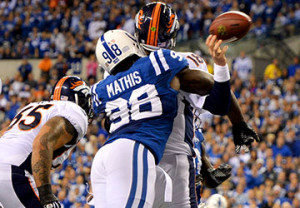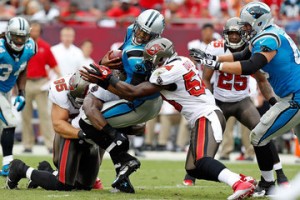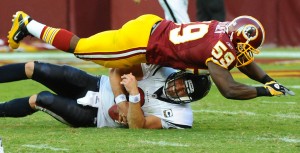The 2011 N.F.L. draft class was initially talked up for its star potential at quarterback: Cam Newton (the first overall pick), Jake Locker (8), Blaine Gabbert (10), Christian Ponder (12), Andy Dalton (35) and Colin Kaepernick (36).
Twenty months later, the most dominant players have been guys named Smith, Miller and Watt. Those three are the front-runners for the defensive player of the year award:
Aldon Smith San Francisco took Smith, a Missouri linebacker, with the seventh pick in the 2011 draft. As a rookie, he was a role player who participated in fewer than half of his team’s snaps but recorded 14 sacks as the team’s designated pass rusher. This year, Smith is a full-time player and continues to be a dominant force. After sacking Miami’s Ryan Tannehill twice on Sunday, he has 19.5 sacks, the most of any player through 13 team games since the sack became an official statistic.
Smith has recorded more sacks in his first two seasons than Reggie White, Derrick Thomas or anyone else who has entered the league since 1982, the year the N.F.L. began officially tracking the statistic. Against the Bears on “Monday Night Football,” Smith recorded five and a half sacks against Jason Campbell, the most by a player in a game since 2007. He is within reach of Michael Strahan’s single-season record of 22.5, set in 2001. But as good as Smith has been, he is arguably just the third-best defensive player from his draft class.
Von Miller The Denver Broncos selected Texas A&M’s Miller with the second overall pick. He had an eye-opening rookie season that was somewhat overshadowed by Tebow Time, but he helped transform the Bronco defense and rightfully earned defensive rookie of the year honors. In 2011, Pro Football Focus rated Miller as the second-best defensive player in the league, and ranked him as the top linebacker against the run and the best pass-rushing 4-3 outside linebacker.
He has only gotten better in 2012. Miller has recorded a sack in each of the team’s last six games, all wins, and now has 16. More impressively, according to Pro Football Focus, Miller’s 16 sacks and 45 quarterback hurries are more than triple the numbers produced by the second-best 4-3 outside linebacker. He ranks as the best pass-rushing linebacker and the best run-stopping linebacker in the N.F.L., and neither race is particularly close. Miller is arguably the best all-around linebacker in the league and perhaps one of the three or four best pass rushers in the N.F.L., too. But Miller still isn’t the most highly regarded member of the 2011 draft.
J.J. Watt The presumptive favorite for the defensive player of the year award remains Houston’s Watt. With an 11-2 record, the Texans are tied for the best record in the N.F.L., and Watt, drafted out of Wisconsin at No. 11, is a huge reason for that. According to Football Outsiders, entering Week 14, Watt led the league with 41 “Defeats” (a turnover, a tackle for loss or a play that prevents a third- or fourth-down conversion); the next-closest player was Miller with 33. According to an e-mail conversation Monday with Aaron Schatz of Football Outsiders, who has been tracking the metric since 1996, only linebackers Ray Lewis (45) and Derrick Brooks (42) have recorded more “Defeats” in a full season, both doing so in 1999.
Watt’s production is remarkable for any player, let alone a 3-4 defensive end. Generally, defensive ends in a 3-4 scheme are not expected to fill up a stat sheet; they are supposed to absorb blockers to enable the linebackers behind them to achieve the glory. But Watt has recorded 16.5 sacks this season and became the first player to officially record 15 sacks and 15 passes defended in the same season. Pro Football Focus ranked Watt just ahead of Miller, and says he’s more than twice as valuable as the next best 3-4 defensive end in football, the Jets’ Muhammad Wilkerson.
Looking for a darkhorse? To identify the man who probably should win the underrated player of the year award — watch a Bengals game. Defensive tackle Geno Atkins was taken in the same draft as Ndamukong Suh but has delivered more production with a fraction of the hype. Atkins was at it again on Sunday against the Cowboys, delivering a sack and two other tackles behind the line of scrimmage, to go with two additional hits and six hurries against Tony Romo.







